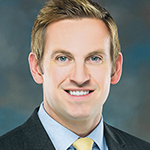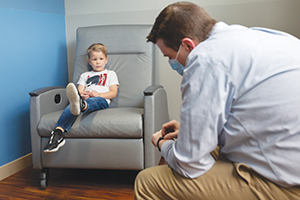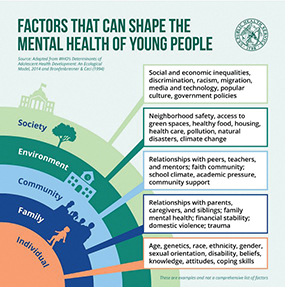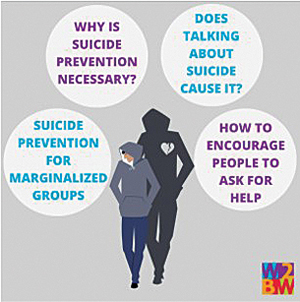By LISA EISENHAUER
Dr. W. Carson Felkel says emergency departments within the Bon Secours Mercy Health system have seen a surge of children and adolescents who have attempted or talked about suicide; who have injured themselves; or who are grappling with anxiety, depression
or other mental illnesses during the pandemic.

Felkel
Young patients with mental health struggles also are inundating the primary care, specialty and school-based clinics affiliated with the system, which operates in seven Eastern states.
As stressed as many young children and teenagers are now, he expects the situation will get worse once COVID-19 wanes and its aftershocks are fully felt.
"We've heard of several waves of the pandemic, but there is going to be a tsunami of mental health and addiction concerns that follows this pandemic," predicts Felkel, a psychiatrist who is Bon Secours Mercy Health system medical director for behavioral
health.

Therapist Joseph Doney poses questions to a patient at SSM Health Behavioral Health Urgent Care at SSM Health DePaul Hospital in suburban St. Louis last May. Care providers say there has been a sharp spike in demand for mental health care for children
since the start of the pandemic
Karen Elshout/© CHA
Felkel's observations and concerns are shared by mental health care leaders and providers at other Catholic health ministries. They also are reflected in several reports and advisories from public health officials and health care organizations.
National emergency
In December, the U.S. surgeon general issued an advisory called "Protecting Youth Mental Health." It cites alarming increases in certain mental health challenges pre-pandemic, such as that in 2019 more than one-third of high school students said they had experienced
persistent feelings of sadness or hopelessness in the past year that kept them from participating in their regular activities, a 40% increase over 2009.
The pandemic appears to have made an alarming trend worse, the advisory says. For example, it notes that figures from the early months of 2021 show emergency department visits for suspected suicide attempts were 51% higher for adolescent girls than the
same period of 2019.

An illustration from "Protecting Youth Mental Health," a public advisory issued by the U.S. surgeon general in December, lists factors believed to be impacting the mental health of children and teenagers.
"The pandemic era's unfathomable number of deaths, pervasive sense of fear; economic instability, and forced physical distancing from loved ones, friends, and communities have exacerbated the unprecedented stresses young people already faced," the advisory
says.
The report urges a national response, including ensuring that every child "has access to high-quality, affordable and culturally competent mental health care."
In October, the American Academy of Pediatrics, the American Academy of Child and Adolescent Psychiatry and the Children's Hospital Association jointly issued a "Declaration of a National Emergency in Child and Adolescent Mental Health." That communique calls on policymakers and child advocates to demand action, including an increase in federal funding for evidence-based
mental health screening, diagnosis and treatment.
Waiting for treatment
Dr. Robin Henderson, chief executive for behavioral health at Providence St. Joseph Health Oregon, says the youth mental health programs offered by her regional system can't keep up with the demand for care.
Those programs include inpatient and outpatient services and partial hospitalization programs in which patients spend their days in treatment and go home at night.

Henderson
"Across the board everything we do in this space has a wait list," Henderson says. "Sometimes those wait lists are weeks, sometimes those wait lists are longer."
The waits are in spite of expansions of some of the programs in recent months.
Once young patients complete the treatment regimens, which typically last six to eight weeks, Henderson says finding continuing care for them is a challenge because few providers are accepting new patients. Additionally, as is happening across the board
in the workforce, she says many mental health providers are leaving the profession.
"What we're seeing is that it's really tough for kids to get into counseling," Henderson says.
The mental health crisis in children has reached the point in Oregon that she has seen statistics showing suicide is now the leading cause of death for adolescents. The state has yet to officially release figures beyond 2019, but historically accidents
have taken more teenage lives than any other cause.
Vulnerable affected most
Like Felkel, Henderson expects the full impact of the pandemic's disruptions on the lives of children to unfold for several years. While older kids might be experiencing depression and other conditions with
immediate effects, she notes younger children might have developmental delays such as speech challenges that add stress to their lives and can take years to overcome.
The surgeon general's advisory mentions that in recent years, suicide rates among Black children younger than 13 have risen rapidly, with Black children nearly twice as likely to die by suicide as white children.
It also notes that socioeconomically disadvantaged children and adolescents — such as those growing up in poverty — are two to three times more likely to develop mental health conditions than others.
Breakdowns of patient data based on race and other factors aren't yet available for the pandemic timeframe, the mental health care executives and providers say, but anecdotally what they are seeing confirms that children from families with fewer resources
or in vulnerable populations are exhibiting higher need for care.

Schafer
Michelle Schafer, SSM Health vice president of behavioral health for the St. Louis region, says the youth patient population in recent months reflects a rise in need for care across all gender, socioeconomic and racial categories. And, she says, there
is a continuation of the pattern for kids from racial minorities and poorer families and those who identify as LGBTQ to be overrepresented.
Disruption cuts lifeline
Schafer and others say factors brought on by the pandemic — the deaths and illnesses, social isolation and financial hardships — have weighed especially heavily on those populations. She cites
the closing of schools as a major disruption in the lives of vulnerable youth that left them with few social outlets and cut off their access to trusted and supportive adults.
"The pandemic drove us to move away from something that is such a significant foundational element for children and adolescents in their growth and emotional development," Schafer says. "We just took the rug right out from under them and with that rug
lots and lots of resources were taken away from them as well."
Felkel says that just as closing schools caused distress for many students, reopening them has caused anxiety for others, such as those who deal with bullying or social anxiety often presenting as an upset stomach or headache. In some cases, that has
prompted parents to keep children at home.
"When children are able to avoid stressful situations, do not have the skills to cope, and are not able to have the resource of therapy to process these difficult emotions, over time kids frequently get worse," Felkel says.
An aspect of behavioral health treatment that impacts kids more so than most adults is that home dynamics usually also need to be addressed, the mental health care leaders say.
"Sometimes a kid gets better but the family remains dysfunctional," Henderson says. "When we're not able to work with the family as a system, I don't think we're able to be successful in the long term."
Just as care options for children are stretched thin by the overwhelming demand and the shortfall of programs and providers, she and others say the same is true for family therapy.
Reducing the stigma
The mental health care leaders see reasons to be hopeful, even amid a crisis that they believe has yet to peak. They note that the publicity around the upsurge in demand for care has led many people to advocate
for increased funding and services. They also say the upsurge in need has led to a more open discussion about the importance of mental health care and that conversation is reducing the stigma around mental illnesses.
"We need to talk about it," Henderson says. "We need to use every avenue we've got whether it's print media, social media, podcasts, whatever. We need to normalize conversations about mental health."
At SSM Health, Schafer and her colleagues are asking policymakers for more funding for programs in the Midwestern states the system serves. In the St. Louis region, they also are trying to build partnerships with other mental health care providers and
community groups to devise a coordinated approach to the surge in demand for youth mental health care and to ongoing needs.
"It's incredibly concerning and worrisome that we're in this situation, but if we all come together, we could be a pretty powerful force to be able to address it and to help children get through this and then to send them on a very fulfilling life path,"
Schafer says.
Health systems expand and stretch pediatric mental health resources
Providers train and deputize teachers to respond to crisis-level demand

Weatherford
Mary Weatherford, a clinical psychologist at SSM Health Cardinal Glennon Children's Hospital in St. Louis, had never used telehealth to counsel patients before the COVID-19 pandemic. Nowadays, much of the therapy she provides to her young patients
is via screen.
"This has been wonderful in creating access for our patients who previously had difficulty coming in for appointments because of lack of resources," she says. Transportation was an issue for families without cars, and many people were reluctant
to have their children come to in-person sessions because of the heightened infection risk, explains Weatherford, who has been in practice for 31 years.

The Work2BeWell program, an initiative of Providence St. Joseph Health, uses visual elements like this one on social media to share the topics of discussions featured on its Talk2BeWell podcast. The initiative provides peer-to-peer support
programs and free educational resources on youth mental health issues.
Michelle Schafer, SSM Health vice president of behavioral health for the St. Louis region, says in addition to the wider use of virtual tools, SSM Health has expanded its hospital-based behavioral health programs for youth where possible. In the
St. Louis region, it has added inpatient beds for patients of all ages and flexed those beds among adult and youth units to match demand.
Dr. W. Carson Felkel, system medical director for behavioral health at Bon Secours Mercy Health, says his system also has greatly increased its use of telehealth for treating emotional, mental and addiction-related illnesses for patients of all
ages. Pre-COVID, he says, there were a few hundred virtual sessions a year; since then they have completed over 70,000 sessions.
In addition, Felkel says that at the school-based clinics the system partners with, clinicians have in recent months put an emphasis on teaching instructors to identify signs of mental illness in students and get those students into treatment.
The system is building on its strategy of integrating all forms of treatment, including behavioral health care, he says. Almost all clinicians at its integrated care clinics screen patients for behavioral health issues, and the system is focused
on seeing that those who are identified with potential illnesses are treated or referred for mental health care.
"We are making that pivot to ensure that when a pediatric patient screens positive (for depression or other mental health issues), we are also delivering the best evidence-based care to them through primary care," Felkel says.
In addition, he says Bon Secours Mercy Health facilities have added social workers to medical teams in areas like pediatric gastroenterology and neurology where children with chronic co-occurring physical and emotional issues often are seen. Those
social workers can connect the patients and their families to behavioral health services.
Dr. Robin Henderson, chief executive for behavioral health at Providence St. Joseph Health Oregon, says while her regional system offers telehealth, virtual care doesn't serve all children in need of mental health treatment well.
"Kids have a lot of Zoom fatigue. Their school is online. Everything we're doing is online," Henderson says. "So then when your therapy's online too it becomes very easy to succumb to all the other distractions. It just is less effective."
As much as possible, Providence Oregon has kept its youth mental health services in-person and it has expanded those services when it has the resources. It has, for example, relocated its eating disorders partial hospitalization program to increase
capacity by six and opened a second adolescent psychiatric partial hospitalization program in which about 20 patients spend their days in treatment and go home at night.
Henderson is also chief clinical officer for Work2BeWell, a Providence initiative that offers educational resources and peer-to-peer support on youth mental health.
The initiative's weekly Talk2BeWell podcast, available on the streaming service Spotify, has focused on several pandemic-related topics in recent months, including the disparities in care available to some populations and low-income families.
The initiative also provides curricula material for educators. The latest additions to that curricula offer teachers and coaches advice on how to work with kids from minority populations to support their mental health needs.
"All those pieces of curriculum are available free and that's where all my hope goes to," says Henderson, "doing what we can to support schools where kids are six to eight hours a day in better being able to identify and address mental health
issues."
— LISA EISENHAUER